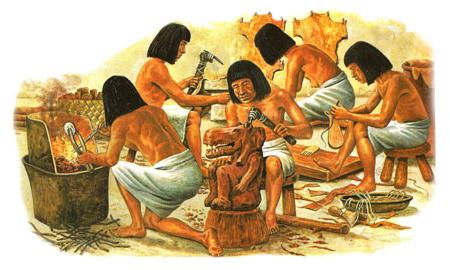In 1905, the Italian archaeologist and orientalist Ernesto Schiaparelli, who had already immortalized his name by discovering the tomb of Nefertari, the first main wife of Ramses II, made another amazing discovery. On the west bank of the Nile, opposite Luxor, he found a group of Theban necropolises, and very close to it was a settlement of artisans who created magnificent temples of the Valley of the Kings. This settlement, Deir al-Medina, is now known to every Egyptologist as a "place of truth", an undistorted mirror showing how artisans lived in Egypt during the time of the Pharaohs.
Deir al-Medina arose under Pharaoh Thutmose I, around the middle of the XVI century. BC e. However, the true art of craft was familiar to the ancient Egyptians long before this event. Archaeologists are known for skillful products of very high quality dating from the early Bronze Age (about 3 thousand years BC). Tools, utensils, figurines and weapons were made of bronze and copper. At first, iron was so scarce metal that the ancient Egyptians considered it to be fallen stars sent from heaven.

The artisans in ancient Egypt who worked with metals were always valuable, but there was no one more important than the jewelers who worked gold and precious stones. Many jewelry and religious attributes found in the tombs of the pharaohs and temples are unparalleled until now, and the technology for their manufacture has not been solved to this day.
Another respected group of artisans were those who worked with wood. This was due to a shortage of quality wood: mainly palm trees, sycamores and sycamores grew on both banks of the Nile. Of these, ordinary furniture was made. Monopoly possession of the pharaoh by trade made it possible to deliver pine trunks to the Egyptian countries from the eastern countries for maritime needs. And from the countries of the South, the most expensive ebony was imported, from which
luxury goods and furniture were made for the upper layers of society.
Artisans stood apart, creating separate architectural elements of majestic tombs and temples from stone. Despite their relatively privileged position, they depended entirely on the orders of the pharaoh or priests. Nobody except them needed “architectural excesses”.
Clay and reed
products were intended for ordinary residents. Artisans in ancient Egypt established the mass production of pottery and wicker chairs, mats, baskets. On dishes, you can often find jewelry in the form of figures, reliefs, images of gods, people and animals.
Linen production dates back to the first dynasties of the pharaohs. Weaved it with the help of vertical and horizontal looms. They also made paint to stain it. The colorfulness of linen clothes can be judged by color paintings in tombs and temples.
The picture will be incomplete if you do not mention the manufacture of papyrus, which has become an integral symbol of ancient Egyptian history. The monopoly on the harvest and processing of reeds, abundantly growing in the Nile Delta, also belonged to the pharaoh. Artisans in ancient Egypt processed reed fibers and stems, and we got papyrus for writing, thanks to which valuable information about events that took place several thousand years ago came to us.

From the many details discovered during excavations in Deir al-Medina, a single picture is formed as a mosaic, showing the life of artisans in ancient Egypt. On the one hand, they were slaves of their involvement in the secrets of the construction of tombs: each of them was supervised by a manager, and a high wall separated the village from the rest of the world. However, they were allowed to live with their wives and children. And indeed, in comparison with other artisans, their position was considered privileged.
The most amazing event for the ancient world is connected with Deir al-Medina - the first strike in the history of mankind! Yes, artisans in ancient Egypt once decided to defend their rights after they had been paid nothing for their labor for a long time. The document telling about this is called Papyrus Strike.
Everyone who has ever visited Egypt, visited his museums, saw the creations of human hands of that time, erected grandiose structures, understands: the main miracle of the world here is not the pyramids and sarcophagi, but the simple people who created them, who knew a lot about their craft and never lives that did not receive a decent reward for him.